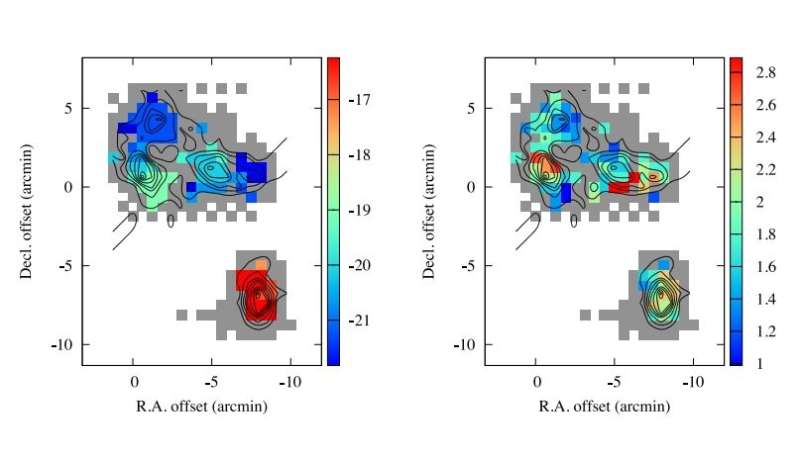The first and second moment maps of ammonia in S235 and S235AB, shown left and right, respectively. Image credit: Burns et al., 2019.
Using the Nobeyama Radio Observatory (NRO), astronomers have investigated a massive star-forming region known as S235. The study resulted in detecting high-density gas in this region, which could be helpful in advancing the knowledge of star-formation mechanisms. The finding is detailed in a paper published August 2 on arXiv.org.
It is assumed that star formation is driven by two groups of mechanisms: spontaneous collapse and triggered collapse. To check which of these mechanisms is dominant and whether these processes can occur together within the same star forming region, astronomers use a technique called ammonia mapping observation. In general, the ammonia molecule has been used to probe the physical conditions in various stages of star formation, including pre-stellar cores, active star formation cores, filamentary structures and large-scale star formation surveys.
An international team of astronomers led by Ross A. Burns of National Astronomical Observatory of Japan (NAOJ), has conducted radio frequency ammonia transition mapping observations of the S235 star-forming region. The goal of this observational campaign was to map the physical conditions of molecular gas in S235.
S235, which belongs to the G174+2.5 giant molecular cloud, is the most active region of star formation in this cloud. It contains multiple dense gas cores that have been extensively studied using ammonia or carbon monosulfide molecular lines. S235 also includes a smaller region, designated S235AB, separated from the "main" body. Observations show that S235AB hosts a younger ionized hydrogen region known as S235A, and hosts very intense star formation indicated by high concentrations of young stellar objects (YSOs).
However, although ammonia maps of S235 have been already made, they are dedicated to the well-known dense cores. So the research conducted by Burns' team focuses mainly on the regions between and around the cores.
"Via spectral analyses of main, hyperfine and multi-transitional ammonia lines, we explored the distribution of temperature and column density in the dense gas in the S235 and S235AB star-forming region," the astronomers wrote in the paper.
The main finding from the study was the presence of high-density gas in inter-core bridges that physically link dense molecular cores that house young proto-stellar clusters. The gas bridges apparently link the cluster-forming cores in the S235 region.
According to the researchers, these bridges appear to be remnants of a fragmentation event that led to the formation of the present day cores from a larger parent cloud. They suppose that the fragmentation was likely driven by impact of the extended ionized hydrogen region to surrounding molecular cloud.
"We conclude that the ammonia gas bridges found in S235 likely represent the hyper-critical remnants of CCC-induced [cloud-cloud collision] fragmentation of a gas cloud involving the C&C ["collect and collapse"] mechanism with likely contribution from the RDI [radiation driven implosion] process. Both processes contribute to the proliferation of triggered star formation, driven by the central HII [ionized hydrogen] region of S235.
Summing up the results, the researchers added that there are generally two ammonia gas components in S235: old quiescent gas of low brightness temperature and younger, more active star-forming gas interacting with the ionized hydrogen region. They added that their study also identified strong water masers associated with star formation in S235AB and one of the cores of S235.
More information: NH3 Observations of the S235 Star Forming Region: Dense Gas in Inter-core Bridges, arXiv:1908.00954. arxiv.org/pdf/1908.00954.pdf
© 2019 Science X Network
























